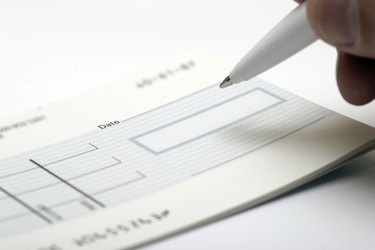
The last line on all checks in the United States and many other countries is printed using a special character font family and technology known as magnetic ink character recognition. Banks use the technique to verify the validity and enhance the security of signed checks, while some airlines use MICR to validate flight tickets. However, the technology is expensive and often impractical when used in small businesses. MICR characters are printed with a magnetic toner or ink made of iron oxide. An MICR reader or scanner magnetizes the characters before it decodes the complete text. The characters are then run through a MICR read head -- a device that converts the characters to waveform, which are then identified by the system.
Readability and Security
Video of the Day
The use of iron oxide-based ink ensures MICR characters are readable even if a document is obscured by marks or overprinted. MICR systems provide a high level of security since MICR characters must to follow a stringent format and use precise iron oxide ink, which makes the documents difficult to forge.
Video of the Day
Few Errors
The error rate for reading MICR characters is small when compared to other character recognition systems. MICR scanners precisely and accurately decipher the characters, provided they follow standards set out by the American National Standards Institute (ANSI) and the American Bankers Association (ABA). For example, for every 20,000 to 30,000 checks processed by a MICR scanner, typically only one read error occurs.
High Standards
Printing MICR documents is demanding due to precise but difficult-to-achieve standards, which is a distinct disadvantage in terms of time consumption. The American National Standards Institute implements and manages all MICR printing standards. It sets precise requirements for MICR character fonts, MICR registration, paper-moisture content and grain and toner adhesion. All MICR character fonts must meet ANSI requirements. MICR fonts that do not adhere to these standards will result in rejected checks at banks and processing errors at other institutions.
Expensive Equipment
MICR readers are expensive and capable of recognizing only MICR fonts written in a specific format. MICR printers run on cartridges that cost far more than plain ink toner cartridges. As of January 2015, a single MICR toner cartridge can cost between $190 and $250.